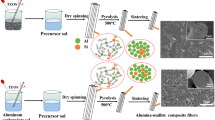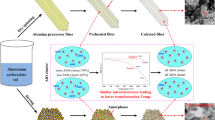Abstract
Via sol–gel processing metal–organic fibers were produced and dried up to 140 °C. For these gel fibers the influence of a treatment in different atmospheres was investigated for the temperature range of 200–850 °C. The atmospheres were nitrogen, water vapor, evaporated nitric and hydrochloric acid and evaporated hydrogen peroxide. In the presence of moisture and especially with acidic moisture fibers were transformed almost completely to their oxide composition (82 mol% Al2O3·18 mol% Y2O3). In these inorganic amorphous structures considerable differences were observed on several structural levels. On the atomic scale, the coordination of Al ions was investigated by 27Al MAS NMR and skeletal density by He-pycnometry. Porosity in the nm scale was characterized by N2-sorption. As a macroscopic effect of different treatment atmospheres, the longitudinal shrinkage was observed. For fibers treated at 500 °C the relative shrinkage varied by 100% (comparing water vapor and nitrogen atmosphere). No simple correlation between the release of organic constituents, the formation of porosity and the shrinkage could be found. These aspects were controlled by the rigidity of the inorganic network against atomic reconstitution. The kind of atmosphere was found to be an effective parameter to control various aspects of the xerogel structure.





Similar content being viewed by others
References
Bunsell AR, Berger M-H (2000) Fine diameter ceramic fibres. J Eur Ceram Soc 20:2249–2260
Krüger R, Glaubitt W, Löbmann P (2002) Structural evolution in sol–gel-derived yttrium aluminum garnet–alumina precursor fibers. J Am Ceram Soc 85(11):2827–2833
Hirano S-I, Yogo T, Kikuta K, Araki Y, Saitoh M, Ogasahara S (1992) Synthesis of highly oriented lead zirconate-lead titanate film using metallo-organics. J Am Ceram Soc 75(10):2785–2789
Kitaoka K, Takahara K, Kozuka H, Yoko T (1999) Sol–gel processing of transparent PLZT((Pb, La)(Zr, Ti)O3) fibers. J Sol Gel Sci Technol 16:183–193
Stacey MH, Taylor MD (1989) Inorganic fibres and their production, European Patent Application EP 0 318 203 A2, Imperial Chemical Industries PLC
Pullar RC, Taylor MD, Bhattacharya AK (1998) Manufacture of yttrium aluminium garnet (YAG) fibres by blow spinning from a sol–gel-precursor. J Eur Ceram Soc 18:1759–1764
Pullar RC, Taylor MD, Bhattacharya AK (1999) The sintering behaviour, mechanical properties, and creep resistance of alingned polycrystalline yttrium aluminium garnet (YAG) fibres, produced from aqueous sol–gel precursor. J Eur Ceram Soc 19:1747–1758
French JD, Harmer MP, Chan HM, Miller GA (1990) Coarsening-resistant dual-phase interpenetrating microstructures. J Am Ceram Soc 73(8):2508–2510 (1990)
Harmer MP, Chan HM, Miller GA (1992) Unique opportunities for microstructural engineering with duplex and laminar ceramic composites. J Am Ceram Soc 75(7):1715–1728
Krüger R (2002) Pyrolyse- und Sinterverhalten sol–gel-abgeleiteter Al2O3-YAG Fasern. Dissertation, Bayerische Julius-Maximilians-Universität, Würzburg
Mei D, Ge Q, Szani J, Peden CHF (2009) First principles analysis of nox adsorption on anhydrous γ-alumina surfaces. J Phys Chem 113:7779–7789
Pocengal DA (1999) Characterization of the uptake of nitrogen oxides by alumina adsorbents. Master Thesis, University of Florida
Acosta S, Corriu SR, Leclercq D, Mutin PH, Vioux A (1994) Novel non-hydrolytic sol–gel route to metal oxides. J Sol Gel Sci Technol 2:25–28
Deng W, Bodart P, Pruski M, Shanks BH (2002) Characterization of mesoporous alumina molecular sieves synthesized by nonionic templating. Microporous Mesoporous Mater 52:169–177
Bagwell RB, Messing GL (1999) Effect of seeding and water vapor on the nucleation and growth of α-Al2O3 from γ-Al2O3. J Am Ceram Soc 82(4):825–832
Coster D, Gruver V, Blumfeld A, Fripiat JJ (1994) Relationships between the structure and the surface activity of nano-sized alumina in acid catalysis. In: Cheetham AK, Brinker CJ, Mecartney ML, Sanchez C (eds) Better ceramics through chemistry VI. Materials research society symposia proceedings, vol 346. Pittsburgh, PA, #286070
Truba M, Trasatti SP (2005) γ-Alumina as a support fo catalysts: a review of fundamental aspects. Eur J Inorg Chem 3393–3403
Allwardt JR, Stebbins JF, Schmidt BC, Frost DJ, Withers AC, Hirschmann MM (2005) Aluminum coordination and the densification of high-pressure aluminosilicate glasses. Am Mineral 90(7):1218–1222
Rouquerol F, Rouquerol J, Sing K (1999) Adsorption by powders and porous solids. Academic Press, San Diego
Ji L, Lin J, Tan KL, Zeng HC (2000) Synthesis of high-surface-area alumina using aluminum tri-sec-butoxide-2, 4-pentanedione-2-propanol-nitric acid precursors. Chem Mater 12:931–939
Pierre AC (1998) Introduction to sol–gel processing. Kluwer, Boston
Scherer GW (1997) Sintering of sol–gel films. J Sol Gel Sci Technol 8:353–363
Bockmeyer M, Löbmann P (2007) Crack formation in TiO2 films prepared by sol–gel processing: quantification and characterization. Thin Solid Films 515(13):5212–5219
Acknowledgments
The authors are indebted to Dr. Rüdiger Bertermann (Institute of Inorganic Chemistry, University of Würzburg) for performing 27Al-MAS-NMR measurements and to Mr. Oliver Schüßler (Fraunhofer ISC) for synthesis of the sols.
Author information
Authors and Affiliations
Corresponding author
Rights and permissions
About this article
Cite this article
Krüger, R., Löbmann, P. Atmospheric control of gel-oxide transformation in sol–gel derived Al2O3-Y2O3 fibers. J Sol-Gel Sci Technol 55, 9–14 (2010). https://doi.org/10.1007/s10971-010-2205-x
Received:
Accepted:
Published:
Issue Date:
DOI: https://doi.org/10.1007/s10971-010-2205-x




